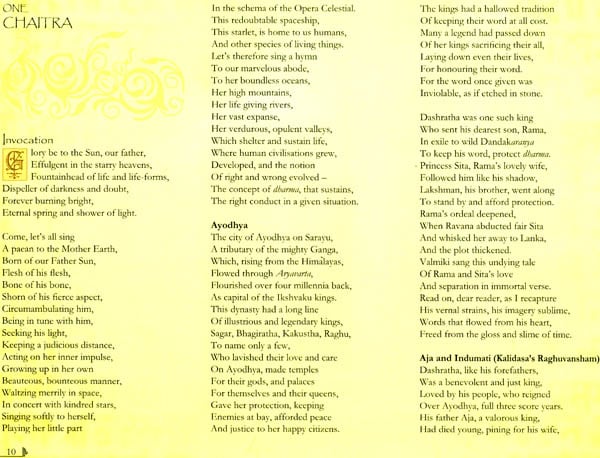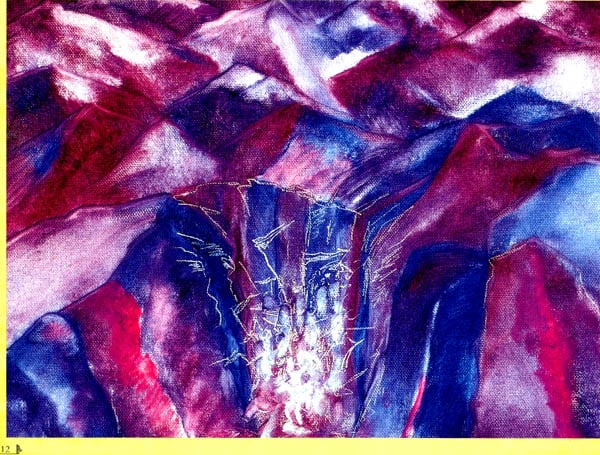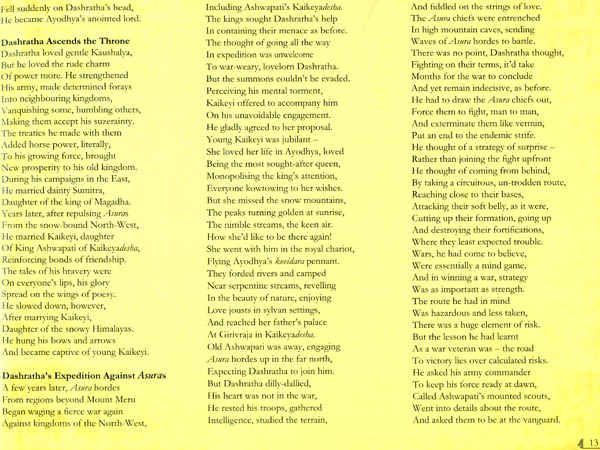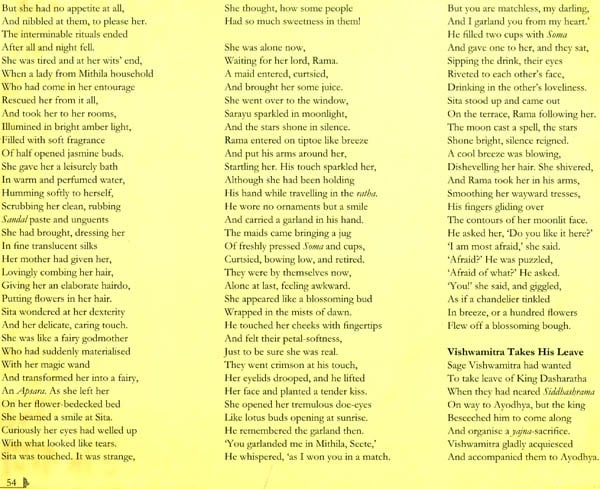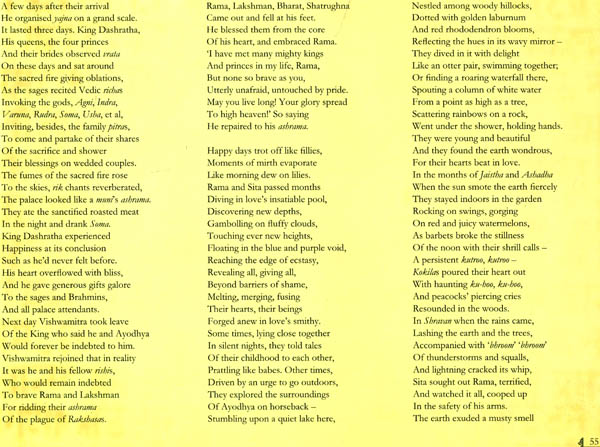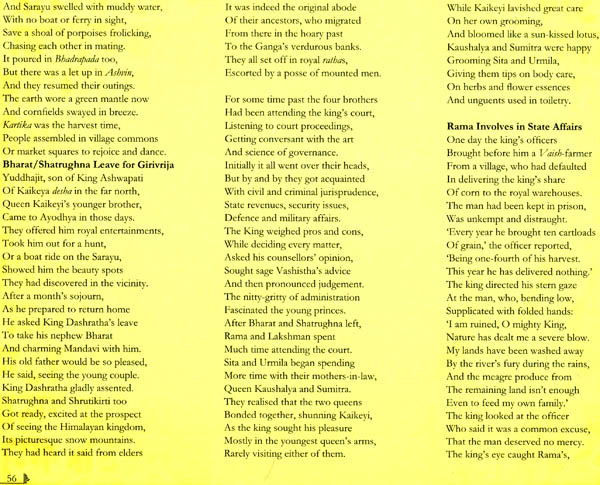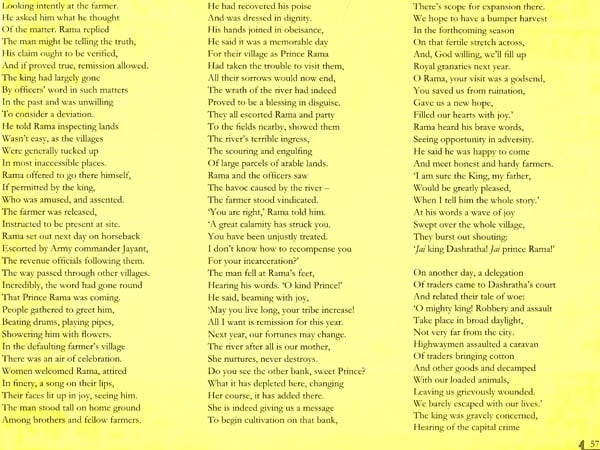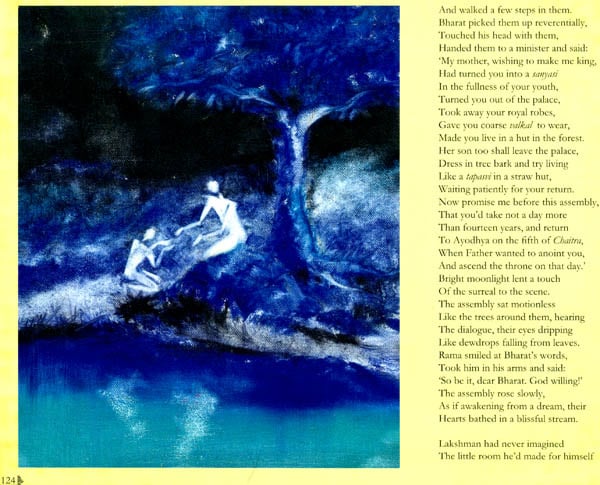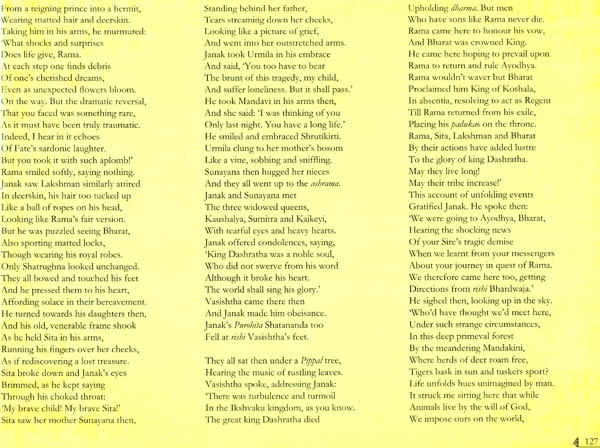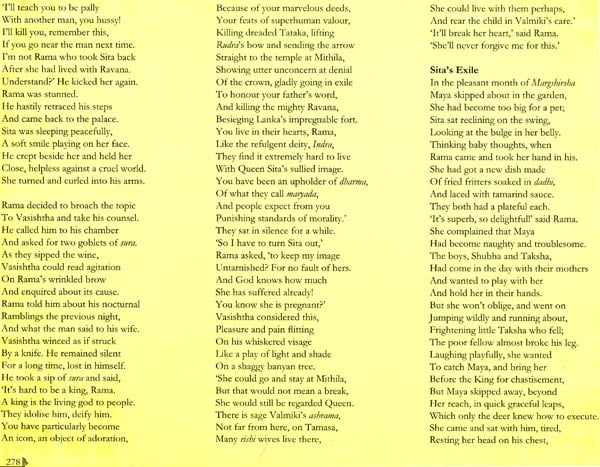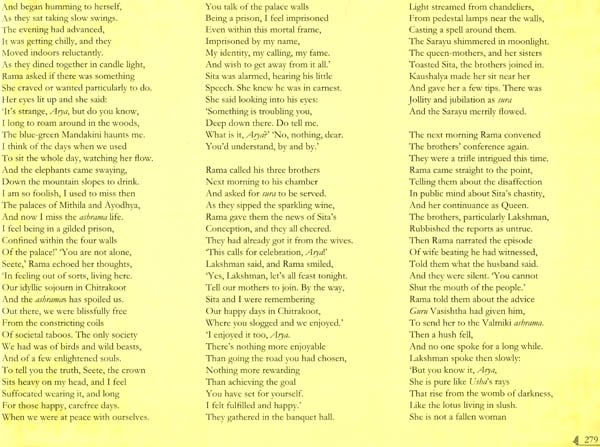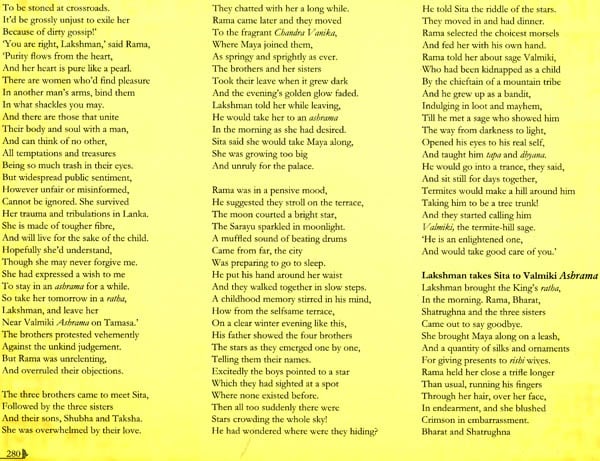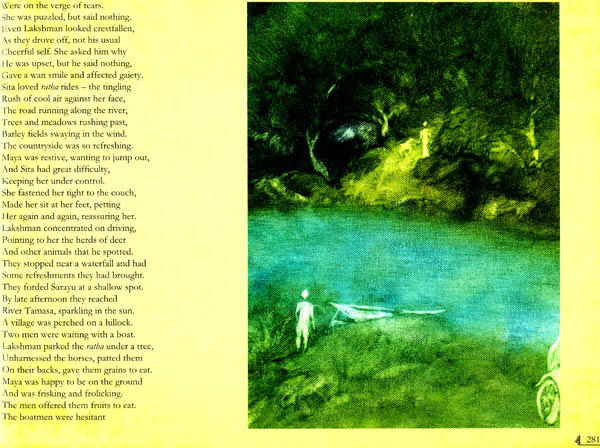
Before He Was God: Ramayana Reconsidered Recreated
Book Specification
| Item Code: | NAD485 |
| Author: | Ram Varma |
| Publisher: | Rupa Publication Pvt. Ltd. |
| Edition: | 2010 |
| ISBN: | 9788129116161 |
| Pages: | 341 |
| Cover: | Hardcover |
| Other Details | 11.0 inch x 8.5 inch |
| Weight | 1.67 kg |
Book Description
Millions of people in India and elsewhere believe that Rama, the hero of Valmiki’s ancient Sanskrit epic, Ramayana, was a historical figure like jesus Christ, and Valmiki,s timeless epic, like the New Testament a faithful account of Rama’s life, his trials, tribulations and triumph.
Confining within the four corners of the original story Rama Varma brings in a refreshing whiff of realism in his retelling washing off the artificial veneer of obscurantism that has distorted and obscured Valmiki’s picture. The reader gets a glimpse of real Rama without the props of godhead provided in the puranic age.
If the killing of a swam occasioned the birth of poetry in Valmiki’s heart. It was the wanton despoliation of his pristine poem. Ramayana, during Puranic times which kindled the sparks of wrath in Ram Varma’s heart which resulted in this book.
In his student days. Ram Varma was drawn to the fount of English poetry and took Master’s degree in English Literature from Allahabad University. He taught the subject at Jodhpur University for a couple of years before joining the Indian Administrative Service in 1964. He served the new state of Haryana right from its formative years in various capacities and rose to be its Chief Secretary.
Searching for his roots after retirement in 2000. Rama Varma entered the Charmed world of the Vedas, Valmiki, Vyasa. Bhavabhuti and Kalidasa, and glimpsed the ancient treasure of India. He searched for an original portrait of Rama in Valmiki but was pained and revolted to see garish colours daubed on it. He had a vision of Rama living in the primeval forests of India battling with life’s unexpected currents and undercurrents with equanimity and fortitude, and vowed to share it with millions of people who believed that Lord Rama walked the earth in flesh and blood.
Even the modern lay reader should find Ram Varma’s rendering of his enduring story from India’s mythical past in free-flowing English blank verse riveting and rewarding.
Vandana Sehagal: Whose Vibrant Paintings adorn this book is Ram Varma’s daughter. Architect, artist, teacher. Homemaker, she is currently researching a project on ‘Infinity and space in Architecture’. Paintings ooze out of her like babbling streams off mountain tops. She has held solo exhibitions of her paintings in Lucknow and Delhi. Her Paintings brings out the quintessential Indian-ness. Whether of a Vedic ashrama, a pillared temple hall or a street in Lucknow
Throughout the centuries, lovers of the Kama story all over India and far beyond have found man~ diverse ways of presenting its essence to audiences of all natures. Countless languages - those of Central and South-east Asia and of Europe as well as modern Indian vernaculars and ancient Sanskrit; literary genres of all types _ stories, poems and drama5, oral and written, simple and sophisticated, narrative, philosophical and lyrical visual representations _carvings in stone and wood, paintings on cloth and paper; performances - dance, puppets, TV serials; all demonstrate the enduring power of the Kama story to inspire and intrigue. Ram Varma's poem continues this tradition of seeking to present the essence of the well-known narrative in a way meaningful to author and audience alike. In a thoughtful, stimulating attempt to search out the heart of the story, he has chosen to focus on wh8t he sees as its historical basis. He has rigorously sought to uncover the fundamental truths underlying episodes he has found difficult to understand. That he has felt impelled be such a sincere and overpowering urge, not to reject such difficult areas as false, nor yet merely to repeat them without thought, but to come to terms with them in his own way is one more tribute to the everlasting potency of Rama's story. Careful readers of before he was God', convinced b~ his conclusions or not, will feel grateful that he has shared his insights with them.
In one respect, all such readers will disagree with the author. The first five words of the Prologue are not true. The work in this volume proclaims w out doubt that Ram Varma is indeed an accomplished poet. He handles the verse form with assurance, and expresses its content in powerful language, natural and fluent, and animated by vivid imagery as these lines from the Prologue with their sustained metaphor, demonstrate:
| Acknowledgements | IX | |
| Timeline | Xli | |
| Foreword | XlV | |
| Prologue | 1 | |
| 1 | Chaitra: | 9 |
| Invocation | 10 | |
| Ayodhya | 10 | |
| Aja and Indumati | 10 | |
| Dashratha ascends the throne | 13 | |
| Dashratha's expedition against the Asuras | 13 | |
| Dashratha kills Shravana | 15 | |
| Yearning for a son- .Asboamedba yajna | 18 | |
| Kaushalya | 20 | |
| Kaikeyi | 22 | |
| Sumitra | 23 | |
| Birth of Rama and brothers | 24 | |
| 2 | Vaishakh: | 27 |
| Vishwamitra comes calling | 28 | |
| Journey to Siddhashram- Stories of Vishwamitra's life | 29 | |
| Rama kills Tataka | 31 | |
| Journey to Mithila | 36 | |
| Rape of Ahalya | 37 | |
| Janak finds a new-born babe | 39 | |
| Sita's swcryamvar | 40 | |
| Sita meets Rama | 42 | |
| Rama's arrow goes on target | 43 | |
| In Janak's palace | 45 | |
| Rama weds Sita | 47 | |
| 3 | Jyaishtha: | 51 |
| Life in Ayodhya | 52 | |
| Sita | 52 | |
| Vishwamitra takes his leave | 55 | |
| Bharat and Shatrughna leave for Girivrija | 56 | |
| Rama involves in state affairs | 57 | |
| Dashratha plans retirement | 61 | |
| Kaikeyi traps Dashratha | 65 | |
| The Play | 68 | |
| Kaikeyi asks for two boons | 69 | |
| Dashratha calls for Rama | 71 | |
| Rama's exile- Vanavasa | 75 | |
| Sita wants to go along | 76 | |
| Lakshman's fury | 78 | |
| Taking leave of Father | 79 | |
| Rama leaves Ayodhya | 83 | |
| Night at Tamasa's bank | 83 | |
| At Ganga's bank- Shringaverpur | 86 | |
| Crossing the Ganga | 88 | |
| Bhardwaja Ashrama | 90 | |
| Crossing the Yamuna | 95 | |
| Chitrakoot- The cottage upon Mandakini's bank | 97 | |
| 4 | Ashadha: | 103 |
| Dashratha's demise | 104 | |
| Bharat's dream | 106 | |
| Return to Ayodhya | 106 | |
| Bharat's lament | 107 | |
| Bharat gives mukhagni to Father | 110 | |
| Bharat's Coronation | 111 | |
| Bharat goes to meet Rama | 112 | |
| At Bharadwaja ashram | 114 | |
| Chitrakoot | 116 | |
| Reunion at Chitrakoot | 119 | |
| Bharat's entreaty for Rama's return | 122 | |
| Janak arrives at Chitrakoot | 127 | |
| 5 | Shravana: | 129 |
| Life in Chitrakoot | 130 | |
| Peace of paradise shattered | 131 | |
| Thunder, rain and the Fire God | 132 | |
| Autumn and Spring- hand in hand | 135 | |
| Beyond Chitrakoot- Dandakara'9a | 138 | |
| Attri's ashrama | 139 | |
| Other ashramas- Other abodes | 141 | |
| Yajna in honour of Rama | 144 | |
| Sita's plea on ahimsa | 145 | |
| Killing of Viradha | 147 | |
| Sharbhanga ashrama | 148 | |
| Sutikshna ashrama | 148 | |
| Agastya's ashrama | 149 | |
| Panchavati | 150 | |
| 6 | Bhadrapad: | 151 |
| A shadow of evil | 152 | |
| Injury and insult | 157 | |
| Khara and Dushana killed | 158 | |
| Shroopnakha heads for Lanka | 160 | |
| Ravana hatches a plan- rushes to Janasthan | 162 | |
| Ravana stalks his prey | 163 | |
| Sita's abduction | 164 | |
| Jatayu's rescue bid | 168 | |
| Rama is surprised by Lakshman | 169 | |
| Search for Sita | 170 | |
| Jatayu dies in Rama's arms | 171 | |
| Sita's unending journey to Lanka | 173 | |
| Ravana's proposition | 174 | |
| 7 | Ashvin: | 177 |
| Search for Sita | 178 | |
| Encounter at Pampa lake | 179 | |
| A cave on Mount Rishyamook | 182 | |
| Alliance with Sugriva | 182 | |
| Rama kills Vali | 186 | |
| Scouting for Sita | 187 | |
| Hanuman crosses the sea | 188 | |
| A yajna in Mahakaal temple | 190 | |
| Meeting Sita in Ashoka Vatika | 192 | |
| Hanuman's adventures | 195 | |
| Arrest and Punishment | 196 | |
| Hanuman returns | 198 | |
| 8 | Kartika: | 201 |
| Hanuman brings Sita's news | 202 | |
| March on Lanka | 203 | |
| Ravana's debaucheries | 205 | |
| Ravana makes overtures to Sugriva | 206 | |
| Ravana in Council | 207 | |
| Vibhishan seeks refuge | 209 | |
| The causeway repaired | 210 | |
| Rama's army reaches Lanka | 215 | |
| Gifts from surprise visitors | 216 | |
| Angad takes Rama's message | 219 | |
| 9 | Margashirsha: | 221 |
| Assault on Lanka fort | 222 | |
| The moat breached | 223 | |
| Meghnada fires naag-paash- Hanuman brings herbs | 224 | |
| Meghnada exults - Ravana | 228 | |
| Ravana's hopes belied- His generals killed | 229 | |
| Ravana enters the fray | 232 | |
| Ravana summons Kumbhakarna | 234 | |
| Kumbhakarna's tranquilizers | 234 | |
| Kumbhakarna goes to battle | 236 | |
| Ravana mourns lVlmbha's death | 238 | |
| Ravana grieves for his four sons | 240 | |
| 10 | Pausha: | 243 |
| Meghnada performs sacrifice | 244 | |
| Meghnada strikes again | 245 | |
| Meghnada slays 'Sita' | 248 | |
| Lakshman kills Meghnada | 250 | |
| Ravana goes to battle | 255 | |
| A ratha for Rama | 255 | |
| Ravana returns to battle | 256 | |
| Rama kills Ravana | 258 | |
| 11 | Magha: | 261 |
| Women wailing for Ravana | 262 | |
| Rama goes to bring Sita | 262 | |
| Lakshman crowns Vibhishan / Shroopnakha visits Rama | 264 | |
| Saudamini meets Rama | 265 | |
| The return to Ayodhya | 266 | |
| Urmila in Ayodhya | 269 | |
| Hanuman meets Bharat | 270 | |
| The Coronation | 272 | |
| Sita revives in love's shower | 274 | |
| The aftermath | 277 | |
| Rama wanders ingognito | 277 | |
| Sita's exile | 278 | |
| Lakshman takes Sita to Valmiki asbrama | 280 | |
| Sita is left alone | 282 | |
| Sita meets Valmiki | 283 | |
| Rohini | 284 | |
| Janak send Shatananda to bring Sita to Mithila | 285 | |
| Sita and Rohini | 287 | |
| Sita delivers twins | 288 | |
| 12 | Phalguna: | 289 |
| Rama awaits Lakshman's return | 290 | |
| Rama sends Shatrughna to Madhura | 290 | |
| Rama sends Bharat to fight .Asuras | 291 | |
| Kaushalya's demise | 292 | |
| Rama performs Ashvamedha yajna | 293 | |
| Lava and Kusha recite Ramayana | 293 | |
| Rama meets the rishis | 294 | |
| Rama sends Lakshman to bring Sita home | 295 | |
| Sita kills the sacrificial horse | 297 | |
| Janak's demise / Journey to Mithila | 299 | |
| Sita's demise | 301 | |
| Floating on Saryu's waves | 303 | |
| Author's Note | 306 | |
| Glossary | 316 |
